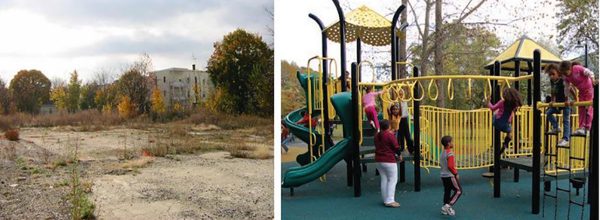It takes effective policies and a robust toolkit to reclaim vacant and abandoned properties as quality community open space. Now more than ever, communities across the US are turning to land banking to stabilize vulnerable neighborhoods saddled by large-scale land vacancy and abandonment. Increasingly, we see municipalities clearing titles, demolishing abandoned houses, expanding side lots, routinely auctioning vacant properties, and even taking on basic maintenance of now vacant and publicly owned land.
But what happens to vacant land that’s not in high demand — often plentiful, and often located in weak-market, historically disinvested neighborhoods? How can communities– especially the people who live in the midst of these parcels— define their vision for vacant land reuse that is meaningful to them, then rally around that vision to reclaim those high-priority parcels for community-defined benefit? And what are the wider “systems change” implications of this work?

Recently, Tangier Barnes Wright, Groundwork USA’s Manager of Land and Water Programs, and I posed these questions and offered our response to attendees of the Community Progress Leadership Institute. At the request of our partners at the Center for Community Progress, we developed and led a workshop for Institute attendees called “What’s Next? Ensuring Your Community’s Vacant Land Reuse Strategies Create Meaningful Near-Term Impact and Long-Term Outcomes.” Over the course of 90 minutes, we explored two challenging but rewarding brownfield-to-park projects — Dr. Nina Scarito Park in Lawrence, MA, and Platte Farm Open Space in Denver, CO.
As managers of these projects, we shared our first-hand experiences of the relationships we nurtured, and the unforeseen obstacles and unanticipated discoveries we encountered, from visioning and planning to short-range and long-term implementation. We also recommended some best practices for implementing adaptive and inclusive processes to achieve more equitable re-development of vacant, underutilized, and sometimes even contaminated properties.
For example, connecting a vacant land reuse project to a broader planning initiative can help to build the unanimous, cross-sector support projects like these often need. Such an approach was taken 14 years ago when Groundwork Lawrence began a campaign to clean up and transform a series of neighborhood brownfields, beginning with a former industrial laundry site that would become the Dr. Nina Scarito Park on the Spicket River Greenway. While responding to expressions of project support in the living rooms of residents living near the site, Groundwork Lawrence also partnered with local CDC Lawrence Community Works to design and lead the ambitious Reviviendo Gateway Initiative (RGI), whose mission was to build human potential, create new housing and commercial space, improve the public environment, and redefine the city’s image.
Project planners focused first on building relationships to foster trust among RGI’s myriad stakeholders. Eventually, a spirit of collaboration and sharing of information and resources blossomed across the community. RGI was the first time a diverse cross-section of stakeholders from every corner of the community was invited around a table together: residents, youth, elected officials, municipal department heads, business and civic leaders, nonprofit leaders, educators, doctors, anyone you could think of. The guiding presumption in this inclusive planning effort was: every single stakeholder, every single program, every single project— including Scarito Park— has both a distinct and interconnected role to play in turning our community around.
We’ve seen projects like this catalyze larger paradigm shifts, too. When vacant land transformation projects like Scarito Park and Platte Farm Open Space become undeniable neighborhood priorities, they offer an opportunity to re-frame place-based neighborhood investments as an economic development strategy. We took every opportunity over the six-year life of the Scarito Park project to make this case because it’s a message that bears repeating. Brownfield-to-park projects offer long-term strategies for countering disinvestment, fostering cohesion, and building wealth by creating jobs, educational youth development “moments,” and multiple entry points for residents to become long-term stewards of their favorite places.
The lasting implications of a holistic and equitable redevelopment approach— in which a project’s “benefit” is defined by the community rather than the developer— call into question the purported promise of more traditional notions of economic development. “Silver bullet” downtown waterfront condo and hotel developments may garner the attention of elected officials, high-profile investors, and the media, but the ripple effects of such projects rarely, if ever, touch the lives of our most marginalized citizens.
Based on the Q&A session that followed our presentation, it’s clear that there’s a healthy appetite among municipal leaders — in right-sizing and long-disinvested communities especially — to figure out how to finance and sustain such pivotal neighborhood-based transformations. We’re excited at the prospect of fostering new and existing nonprofit-municipal coalitions and public-private partnerships. Through our ongoing Brownfields Technical Assistance Program, we seek to kick-start and achieve vacant land transformation victories like ours in low-moderate income neighborhoods and communities of color. We thank the Center for Community Progress for giving us the opportunity to share some of our insights with such an engaged audience, and look forward to continued partnerships with them.
Kate O’Brien is Groundwork USA’s Director of Capacity Building
